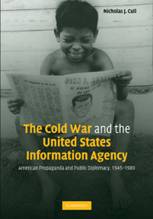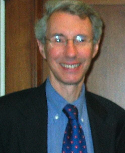American Propaganda and Public Diplomacy, 1945 – 1989
 Review by Michael Schneider, Ph. D.
Review by Michael Schneider, Ph. D.
Nicholas Cull, The Cold War and the U.S. Information Agency: American Propaganda and Public Diplomacy, 1945 – 1989, Cambridge: Cambridge University Press; 2009 Paperback edition, ISBN 13:9780521142830, 580 pp., $36.99
{Note: The Paperback edition will appear November 29, 2009}
Nick Cull has written a masterful history of USIA and U. S. public diplomacy. Cull combines encyclopedic archival research with wide-ranging interviews to document the evolution of the Agency. His book exhibits keen understanding of leadership and bureaucracy and sensitivity to the personalities who led USIA over the past half-century. He deftly links the evolution of the Agency to the broader policy and public affairs arena. This is the definitive record of USIA in its several policy and informational roles. Cull is open-minded and fair in use of documentation and in his judgments. While not taking sides regarding the many organizational debates, the author clearly favors the journalistic independence and integrity of VOA, although acknowledging that the role of the Voice differs from private broadcasters.
(A brief disclaimer: I have known and worked with Nick Cull for many years, and read portions of the manuscript in draft. As a bit player in the drama, I am also not disinterested. Nevertheless this review attempts to provide a dispassionate assessment. )
Cull’s history of USIA encompasses almost half a century, cramming much salient detail, chronology and narrative in the space of some 500 readable pages.
Cull delineates three broad “maps” of USIA involvement abroad, not surprisingly, East/West, North/South, and West/West. Five broad, often competing functions of USIA are delineated: listening, advocacy, cultural diplomacy, educational diplomacy and international broadcasting. The author envisions these as “trajectories” that provide the warp threads of the narrative of eight USG Administrations. Additionally he delineates seven “essential themes:” the relation of USIA with the NSC and White House (much less so with State); the conceptual development of public diplomacy with its own terminology; the (often fractious) development of the several elements of USIA; the domestic context of USIA’s work, including Congressional influence and the budget; the ongoing issue of leadership in U. S. public diplomacy; the professional development in this field, and the changing nature of the task of public diplomacy.
Cull proceeds in quite workmanlike fashion to deal with the trajectories and themes through the eight Administrations from 1945 to 1989, and offers a very thoughtful reprise of these themes at the conclusion of the book.
The sum total depicts the sensitivity and self-absorption of Agency leaders and practitioners with the roles and direction of USIA. This is quite appropriate for any multi-disciplinary pursuit such as public diplomacy and an organization as decentralized as USIA, divided between Washington and disparate field posts around the globe.
Of course some themes, issues, and roles receive more attention than others. This is not to disparage the choices in coverage by the author, but to note that the reader will need to turn to other works for more extensive treatment of field operations and of the educational and cultural exchange program. The book is strongest in its analysis of issues of advocacy and international broadcasting. The listening (advisory) function receives some attention, with perhaps more analysis possible, both of Washington and the field. As the author notes, this was one of the most important missed opportunities of U. S. foreign policy.
After a brief overview of the roots of public diplomacy in the instruments of persuasion from World War I, the author launches his analysis in the Truman years and The Campaign of Truth. Impressed by the “P factor” (psychological), Eisenhower is credited with including USIA leadership in more senior level White House deliberations than other Administrations, and with sanctioning major global multi-media thematic campaigns such as Atoms for Peace and People’s Capitalism.
The McCarthy impact on the Agency, particularly broadcasting, is discussed. More could always be said about the residual impact of McCarthyism on Agency behavior, including the choice of books and magazines for USIA libraries and the ‘blacklisting’ of possible speakers abroad.
Cull elicits the unfulfilled promise of the Kennedy Administration and the Edward R. Murrow era of USIA. Murrow personified the highest professional aspirations of the organization. His principles and sayings remain trenchant and relevant today. Sadly Murrow’s illness in 1963 and death in 1964 kept him from tangible organizational change.
Despite his prominence, Murrow did not play the policy advisory role he wanted or that the Kennedy team had implied it sought. The author documents several of the most prominent imbroglios, including the failure to consult Murrow before the Bay of Pigs blunder, and his slight influence on subsequent policy making. The Eisenhower and Reagan eras involved more systematic USIA public affairs advice in Washington.
As Cull points out in his treatment of the Lyndon B. Johnson years, the frustrated civil rights movement, the youth explosion in the U.S. and the Vietnam War negated the high expectations generated by JFK and Murrow. Domestic unrest and particularly Vietnam cast a pall on U.S. standing worldwide and USIA public diplomacy, as Cull shows in his treatment of the LBJ stewardship. America’s international standing would not be so low until the reaction in Europe and the Middle East to the U.S. occupation of Iraq after 2003.
There is brief but important coverage of JUSPAO in the Johnson years and discussion of the leadership of Barry Zorthian. Much more remains to be written, particularly, as Zorthian pointed out to the author, a retrospective counter-insurgency analysis of the efficacy of our takeover of communication in Vietnam from the inept Vietnamese leadership, parallel to U.S. military assumption of the role of the ARVN.
Cull identifies Frank Shakespeare as “the true believer” whose strong anti-communism led him to attempt to shape an independent communication policy from Henry Kissinger’s foreign policy and led Kissinger, and State, to exclude Shakespeare from national security policy. Cull briefly documents Frank Shakepeare’s attempts to shape Agency media output in more hard-hitting anti-communist direction, including his support for Motion Picture Director Bruce Herschensohn, an ideological soul mate. There are several untold back stories regarding Shakespeare’s impact, particularly his effort to re-educate seasoned FSOs through visits and assignments to the USSR.
The author focuses on the dramatic organizational changes that occurred in the Jimmy Carter Administration with the merger of State/CU with USIA, and how carefully USIA Director Reinhardt sought to integrate the cultural and educational staff and re-shape USIA into ICA. This was not just a merger; Reinhardt genuinely sought to move USIA/ICA toward a longer-range professional world view. Educational and cultural affairs would complement Agency informational and advocacy activities with an emphasis on longer-term perspectives and goals; conduct of programs under a 2nd mandate would help Americans become better educated about the world. Ironically, some of the program procedures and reorientation of work, placing more responsibility in the field, were undercut by rigidities in the planning system and conflicted with Agency area office prerogatives, already diminished in the Shakespeare/Loomis era. International crises in Iran and Afghanistan and the rise of American conservatism and Ronald Reagan led to the end of the ICA experiment.
Cull found Charles Z. Wick to be a very different kind of director of USIA – variously seen as a zany confidant and loyalist of Ronald and Nancy Reagan, a wealthy entrepreneur, creative, ambitious, feisty, mercurial, demanding, and much more. The author describes the ups and downs of this volatile newcomer to Washington policy and politics, and catalogues Wick’s ambitious efforts to support the President and refute Soviet propaganda and disinformation. While USIA anti-disinformation efforts responded to the ongoing flow of Soviet anti-American pejoratives, Mr. Wick buttressed Administration efforts to encourage glasnost and perestroika, and encountered Soviet officials and media leaders in several rounds of Information and Cultural Exchange Talks, all treated briefly by the author.
It is difficult in a brief chapter to fully depict the diverse initiatives of Charlie Wick and his personal impact on a host of U. S. policy makers and others here and abroad. There is much more to say, particularly about the broadened definition of audiences and the vicissitudes of the educational exchange program. There was also one missed opportunity, to more fully describe the central role of the USIA posts in Europe in support of the INF emplacement. Through careful analysis of public and elite opinion, PAOs made key recommendations to an otherwise intrusive Administration to help supporters but not to dominate the debate in Europe.
Early in the text, the author apologizes to career USIA officials “….I am particularly aware that I have privileged the story of the high politics of public diplomacy at the expense of efforts of yeomen in the field, and that I present an analysis of ideas of transient political appointees while passing over the work of thirty-year career veterans.” Let’s hope that others add to the growing body of oral histories and memoirs.![]()

Michael Schneider is a professor of practice at the Maxwell School of Citizenship and Public Affairs at Syracuse University and director of the University’s Washington International Program. In the 1980s Schneider was deputy associate and acting associate director of USIA for policy and programs and served as USIA liaison with the National Security Council. He was senior advisor to the Under Secretary of State in the mid-1990s. He served as executive secretary of a panel of U.S. and international leaders who examined the Fulbright Exchange Program, and authored the report, Fulbright at Fifty, and a subsequent report to the State Department, Others’ Open Doors.
